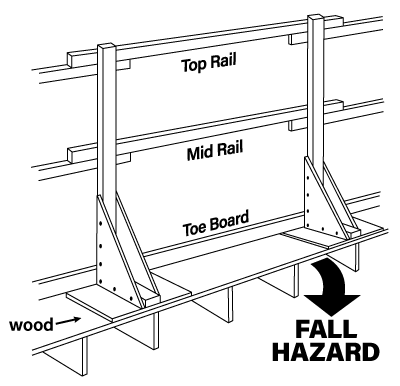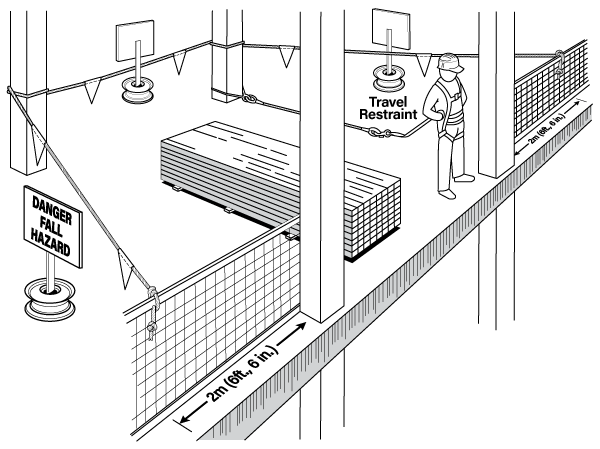Fall Protection - Guardrails
On this page
- What are guardrails?
- Are guardrails and handrails the same thing?
- When do you use guardrails?
- What are the main types of guardrails?
- What is meant by load specifications?
- What else should be considered when installing guardrails?
- What should be done if you need to remove the whole or part of a guardrail?
What are guardrails?
Back to topGuardrails are a stationary (or "fixed") system used to protect workers from falls when working at heights. Guardrails are a preferred means of protecting workers because the system does not rely on the worker to be trained to use, inspect, and wear a fall protection system.
Well built guardrails are a reliable and convenient means of fall protection because they act as a visible and physical barrier to help prevent falls from heights or between levels including falls from roofs, balconies, stairwells or falls into open holes. Guardrails are used where covers, floors or walls cannot be installed or are not practical.
Guardrails are used in every industry and can be seen in:
- retail shops
- industrial settings
- construction sites
- warehouses
- shipping facilities
- landscaping and work areas in natural settings, and
- any workplace with an accessible rooftop.
Are guardrails and handrails the same thing?
Back to topWhile guardrails often also have handrails, they are not the same thing. Handrails serve as a handhold people use to support themselves while using up or down stairs, ramps, or crossing flat surfaces. Guardrails are designed to prevent falls over an unprotected edge or into an opening.
When do you use guardrails?
Back to topInstall a guardrail if the fall hazard or working at heights cannot be eliminated. Guardrails should be used when a worker could have access to the unprotected edge of any of the following work surfaces and is exposed to a fall from a height or between levels. If an employee can fall into or onto dangerous equipment such as a conveyor belt, it is also good practice to prevent such falls by installing guardrails and toe boards. Make sure the guardrail is installed around the edge or opening before work begins.
Installing a guardrail is good practice:
- around a balcony or mezzanine
- at the edges of catwalks or overhead conveyor platforms
- along the bridges
- around scaffolds, raised platforms, or open platforms on aerial devices
- at the edges of roofs where work may be performed
- along the open edges of elevated working areas such as the upper floors of building under construction or being repaired
- around work elevated work surfaces including platforms, scaffolds, runways, or ramps
- around openings in floors, roofs, and in working surfaces where the openings are not covered or protected
- open edges of slab formwork for floors and roofs
- any where workers could fall into water, operating machinery, or hazardous substances.
In most jurisdictions, use of a guardrail is specified for certain circumstances. Always check with your jurisdiction for exact requirements.
What are the main types of guardrails?
Back to topThere are two main types of guardrails - job built guardrails and manufactured guardrail systems. While job built guardrails are typically made of wood, manufactured guardrail systems are available in a variety of materials and may have parts made of mesh, netting or fencing. Guardrails typically feature a top rail, mid-rail, toe boards with evenly spaced vertical posts.

Regardless of type, make sure all guardrails used meet the regulatory requirements and are built according to requirements (e.g., height and spacing requirements of guardrail components and/or are installed according to the manufacturer's instructions.
To prevent people from falling, guardrails must:
- be high enough to prevent a person from falling over the top of them.
- be strong enough to withstand the force of the number of people likely to lean or push up against them. Consider also possible impacts from tools and other materials used nearby.
- have evenly spaced posts that areclose enough together to prevent people from falling through the gaps. If using a manufactured guardrail system that does not use vertical posts, it must provide equal protection against similar gaps.
- be installed as close to the open edge as is reasonable.
- extend along the whole length of the opening or unprotected edge.
- be made of materials with smooth surfaces that are not abrasive and will not cut skin or snag clothing. Common materials used are wood and metal.
What is meant by load specifications?
Back to topRegulations often require a load specification. This requirement refers to the amount of force that guardrails may be expected to support, and is measured in newtons (N) or pounds (lbs).
The force requirements will depend on the application of the guardrail and the legislative requirements in your jurisdiction.
The CSA Standard Z797-18 Code of practice for access scaffold also provides minimum load bearing and height requirements for guardrails and toe boards.
What else should be considered when installing guardrails?
Back to topMake sure workers in the area near the unguarded edge are protected from falls by other means (travel restraint, fall arrest, netting, etc.) until the guardrail is completely installed.
When building guardrails on the job,
- Consider how long the guardrail will be required (and factor in the local weather and other environment conditions).
- If building the guardrail from wood, only use lumber that is construction grade quality or better. Some jurisdictions require the lumber used be spruce, pine or fir (S-P-F) timber.
- Inspect the lumber for damage or rot. Lumber should have no visible defects that could affect its loadbearing capacity.
- Choose the appropriate fasteners for the materials being used. Make sure all nails and other fasteners used are strong enough to withstand the forces applied to them.
- Make sure the wooden surface is smooth and that the finished guardrail does not have protruding nails, screws, or rough edges.
- Do not reuse old construction materials.
Other items to consider include:
- The number of people in a work area
- The size of the work area
- The weight and type of tools or materials being used in the area
- Whether the guardrails are to be a permanent or temporary solution
What should be done if you need to remove the whole or part of a guardrail?
Back to topIt may be necessary to remove guardrails or sections of a guardrail in a working area, such as unloading materials at a site above ground level. Follow good practice to ensure there are not falls through an unprotected opening. Improper removal of the guardrails can leave protruding edges or parts, like nails, that may injure workers, so use the right tools and follow all established construction procedures.
Before removing a guardrail:
- Identify the work area that will be affected by the removal of the guardrail. Mark an area large enough to keep unprotected employees away from the fall hazard. For example, in Ontario it is recommended that this distance be "at least 2 metres (6 feet, 6 inches) from either side of the opening and at least 2 metres back from the open edge of the work surface".
- Clear that area so it is free from slip or trip hazards such as ice and debris.
- Mark it off as a fall hazard area with caution tape or a warning barrier.
- Alert all those working nearby that a guardrail is being removed. Post warning signs outside the roped off area alerting anyone of the danger from the unprotected fall hazard.
- Set up travel restraint or fall arrest systems for everyone working in the fall hazard area after the guardrail is removed.
After the guardrail is removed, everyone working inside the marked off area must use a travel restraint or fall arrest system at all times.

When reinstalling or rebuilding a guardrail, make sure it is installed as intended according to the manufacturer's instructions or its original design. Store the removed guardrails or sections in a place where they cannot fall on someone or become a trip hazard.
- Fact sheet first published: 2019-11-07
- Fact sheet confirmed current: 2023-01-10
- Fact sheet last revised: 2019-11-07
